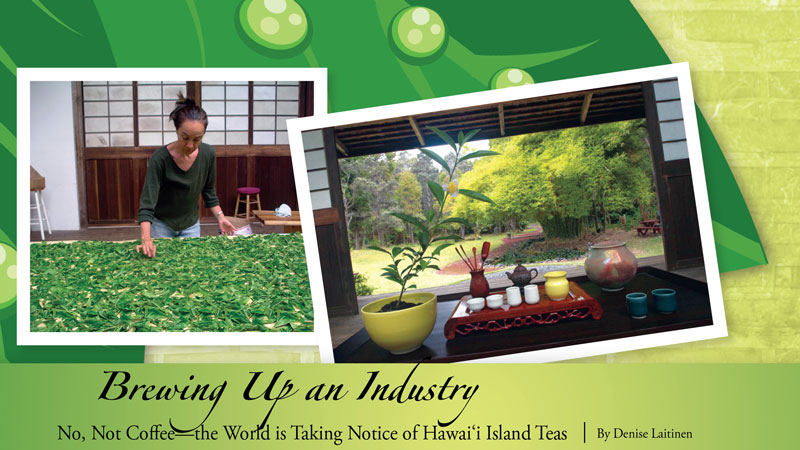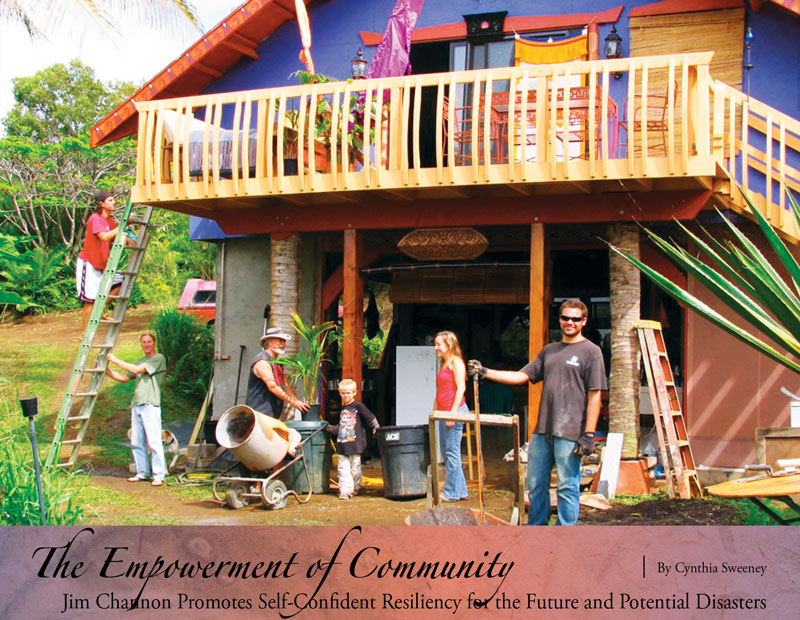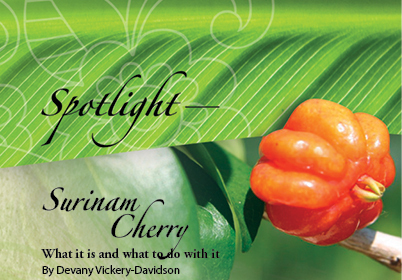
Brewing Up an Industry: No, Not Coffee—The World Is Taking Notice of Hawai‘i Island Teas

By Denise Laitinen
Whether you’re a coffee enthusiast or a tea devotee, there’s a new brew at the breakfast table, and Hawai‘i Island could be the beneficial host for rooting this profitable agricultural product. Black, green, white, oolong, hot or iced, whatever the type, tea is the oldest and most popular drink in the world with origins dating back to 2,700 B.C. in ancient China. According to the Tea Association of the USA, more than 154 million Americans drink tea on any given day.
What started out as an experiment among researchers and farmers has turned into a successful, local agro-industry that is making the tea world stand up and take notice. Today, more tea is grown in Hawai‘i than in any other state in the U.S.
Hawai‘i Island farmers grow the majority of that tea.
Like Kona coffee and its local cousins, tea flourishes well in sub tropical climates, in upland elevations to 7,000 feet. It seems like a natural crop for Hawai‘i, but attempts at growing tea in the islands in the late 1880s failed to take root. It wasn’t until the past decade that tea started being grown commercially on Hawai‘i Island.
In the late 1990s, Milton Yamasaki, recently retired from the Mealani Experimental Station in Waimea, part of the University of Hawai‘i College of Tropical Agriculture and Human Resources (CTAHR), and Dr. Francis Zee, with the U.S. Department of Agriculture (USDA) Pacific Basin Agriculture Research Center, were instrumental in helping tea get established as a possible commercial farm crop.
“We were looking at doing alternative crops,” says Yamasaki. “A lot of the farmers were having a hard time with O‘ahu farms taking over the markets.” At the time, several small farmers were experimenting with different crops to find a competitive edge. “I talked to Dr. Zee about doing alternative crops. I didn’t know anything about tea, so I wanted to learn more about it.”
“I found out that tea grows well in upland areas,” adds Yamasaki. In 1999, USDA and CTAHR planted three test sites at Mealani, Waiakea, and Volcano. “We started with 20 plants of 16 varieties of tea,” says Yamasaki. Dr. Zee and Yamasaki were looking at the crops more from a scientific point of view. They studied the rate of growth, the plant’s resistance to various pests, and its viability as a crop. They also wanted to create a crop that was distinctive.
“I wanted to process something that was uniquely Hawaiian,” says Yamasaki. They tweaked different types of tea looking to weed out plants that tasted bitter and create a tea with a sweet and floral aroma.
At the same time John Cross was experimenting at his farm in Hakalau. He was one of the first to get involved when C. Brewer was experimenting with different types of crops in the 1990s. C. Brewer ultimately abandoned the enterprise, but John kept plugging away. Johnny’s Garden, as his tea farm is known, is now 17 years old and is one of the oldest tea farms on the island.
After a few years, Dr. Zee turned things over to Yamasaki, who continued tweaking tea plant types and varieties at different elevations. Other pioneer farmers like Mike Riley and Eva Lee, both of Volcano, soon joined in and started growing tea on their respective farms.
In 2003, the Hawai‘i Tea Society was formed by a small group of farmers with the assistance of CTAHR Extension Agent Dwight Sato to help the fledgling industry. Tea typically takes five years to reach maturity. While the crops were maturing in the fields, the farmers kept busy, spending those intervening years from 2000-2005 learning how to grow tea, aspects of harvesting, production yields, propagation, and marketing. Mike Riley, founding president of the Hawai‘i Tea Society, credits Dwight Sato with nurturing the growing industry and bringing guest lecturers to the island to teach local farmers.
It was one of these workshops that helped inspire Kimberly Ino and her husband Takahiro to start their own tea farm, Mauna Kea Tea.
“I call it a modern day field of dreams,” says Ino. She and her husband both have backgrounds in environmental science and are organic farmers by nature. They knew they wanted to pursue farming, and when they saw an ad for a workshop on growing tea within a month of buying their Ahualoa property in 2005, “It just called to us.”
Like other local tea farms, they started small. “It took us six months to plant our first two rows,” she recalls. “The next year we planted a whole field and the year after that a whole acre. It’s going pretty quickly.” Any day now their tea farm will have another distinction: they’ll be certified organic. “It’s really exciting for us,” says Ino.
Just as Ino and her husband were starting, pioneer farmers like Eva Lee and her husband Chiu Leong, owners of Tea Hawai‘i & Company, were seeing their first crops mature in 2005.
And people started to take notice.
“What we are doing here is getting the attention of people who produce tea in other countries,” says Lee. “In most countries, tea cultivation is at high elevations, such as in China and Japan. Hawai‘i is a new experiment. People are growing tea from sea level to 4,000 feet.”
“Hawai‘i tea growers are taking the idea that tea has to be grown at high elevations and turning it on its head,” adds Lee.
Taste is another key reason Hawai‘i-grown tea is garnering so much attention. “I feel that Hawai‘i-grown teas have something special about them not found in other tea,” says Hawai‘i Tea Society President Bob Jacobson, who owns Hawai‘i Rainforest Tea.
“Our teas don’t grow bitter if over-brewed and all seem to have a remarkably complex, floral taste not found elsewhere,” adds Jacobson.
Yamasaki agrees. “We can make a Hawaiian tea that no one else can.” He also points out that Hawai‘i-grown tea is a special market. “We were looking at creating a specialty tea,” adds Yamasaki. “You can’t get 100 bags for two dollars, but we make a good product that’s competitive.”
Ino echoes that sentiment. “Our market is established tea drinkers who recognize what a unique product we have. It’s not so much for the first-time tea drinkers.”
Just like the island’s superior coffee products, Mainland people are willing to pay a premium for Hawai‘i-grown tea. Some tea houses, such as the Samovar Tea Lounges in San Francisco, charge upwards of $15-20 for a single pot of Hawai‘i-grown tea.
Fortunately, prices are a lot more reasonable closer to home. Many tea farms sell their products at local farmers markets. Lee and her husband sell teas from four different farms at the Waimea Farmers Market at Parker School. Ino and her husband sell their tea online and just marked their second anniversary of selling tea at the Waimea Homestead Market. “Ultimate Burger in Kona sells quite a bit of our iced tea,” she points out.
Others like Bob Jacobson plan to sell directly to mainland and international markets.
As the island’s tea industry grows, they also help other local businesses grow as well. Tea Hawai‘i & Company has partnered with Volcano Winery to create an infusion tea wine. And the Winery recently began offering a winery and tea package tour. At Mauna Kea Tea all the tea cups used for tea tastings are hand crafted by Holualoa artist Sharon Seastone.
For Hawai‘i tea growers, the past five years have been about growing the commercial market for their product and education. That paid off in 2010 when the Hawai‘i-grown tea industry was invited to attend the World Tea Expo—a big honor for such a young industry. Lee, who led the delegation that also included Ino, remembers how the Hawai‘i tea made an impression. “People from all over the world come to the World Tea Expo and our teas were being compared to teas in other countries.” Not bad for an industry little more than a decade old.
The reception was so favorable, Tea Hawai‘i & Company has been invited back to World Tea Expo this June, when Lee will once again have a booth.
As for the future of the tea industry in Hawai‘i and the Big Island in particular, the sky is the limit. Nationally, tea sales have increased for 19 consecutive years and last year retail supermarket sales of tea passed more than $2.1 billion.
“Right now, everyone is doing everything by hand,” says Lee. “We’re just now getting mechanized and when that increases, then our production will really take off.”
“It’s an interesting time to see where [this industry] goes,” says Lee. “Tea doesn’t have just culinary purposes. There are cosmetic, medicinal, and pharmaceutical entities that are interested in what we are doing with tea.” Lee adds that she gets calls on a daily basis from groups on the mainland and other countries interested in the results tea farmers are experiencing here on the Big Island.
“The world tea market is just waiting for Hawai‘i to develop more tea. There’s a huge market,” says Lee.
Some of the tea farms on Hawai‘i Island—Most offer farm tours and/or tea tastings.
- Hawai‘i Rainforest Tea | Hawaiian Acres | Bob Jacobson
- Johnny’s Garden | Hakalau | John Cross
- Kona Tea Garden | Ahualoa | Kathy and Merle Wood
- Mauna Kea Tea | Ahualoa | Takahiro and Kimberly Ino
- Moonrise Ridge Tea Garden | Hilo | Sherri Miller
- Tea Hawai‘i & Company | Volcano | Eva Lee
- Volcano Tea Garden | Volcano | Mike Riley
- Hawai‘i Tea Society


